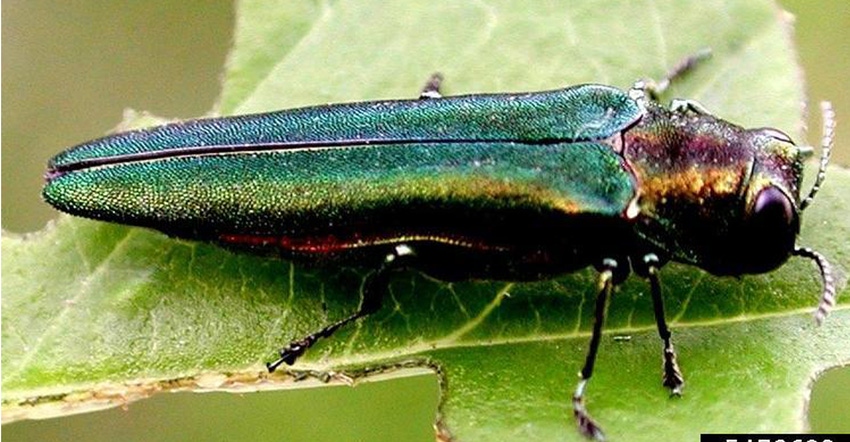
Emerald ash borer, an invasive insect pest from Asia, has been discovered in Crawford, Delaware and Page counties. EAB has now been detected in 64 of Iowa’s 99 counties. It bores into ash trees and feeds on tissue beneath the bark, ultimately killing the tree.
The Iowa Department of Agriculture made the announcement Aug. 8, adding the three new EAB counties to the list. Insect samples were collected from Denison (Crawford County), Edgewood (Delaware County) and Clarinda (Page County). Officials with USDA’s Animal and Plant Health Inspection Service confirmed the samples positive for EAB.
“Despite EAB being linked to nearly two-thirds of Iowa’s counties, people are encouraged to report suspected infested ash trees in counties where it has not yet been confirmed,” says Mike Kintner, the Iowa Department of Ag’s EAB and gypsy moth coordinator. “Tracking the whereabouts of emerald ash borer across the state is a useful component of treatment recommendations.”
EAB-infested ash trees can include thinning and dying crowns, water sprouts along the trunk and main branches, increased woodpecker activity that causes the tree to look like it is losing patches of bark, S-shaped galleries on the inside of bark, vertical bark splits and small D-shaped exit holes where adult beetles emerged from the trees. The larval stage of EAB feeds beneath the bark and disrupts movement of water and nutrients within the tree. Once infested, ash trees continue to decline and usually die within two to four years.
Recommended timing for treatment
For this year, the treatment window for soil-applied preventive treatment measures (soil injection, soil drench, or granular application) and basal bark sprays has ended, Kintner says. Trunk injections can be done now through the end of August if a landowner is interested in protecting a valuable and healthy ash tree within 15 miles of a known infestation.
Good soil moisture is critical for the effectiveness of any systemic insecticide movement in a tree.
To find a certified applicator in your area, visit ISU Extension.
State continues to track EAB
The EAB adult beetle can fly only short distances, but people have largely contributed to the spread of this pest by moving infested material, particularly firewood. EAB larvae can unknowingly be transported beneath the bark of firewood. People are reminded to help protect areas free from EAB by only purchasing and burning locally sourced firewood.
The state of Iowa continues to track movement of EAB on a county-by-county basis. To report a suspected infestation in a new location, contact one of the following:
• IDALS Entomologist Office at 515-725-1470
• Iowa Department of Natural Resources at 515-725-8453
• Iowa State University Extension Entomology at 515-294-1101
To learn more about EAB and to view known locations in Iowa, visit iowatreepests.com.
About the Author(s)
You May Also Like




